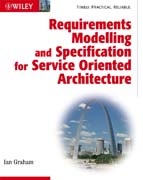
Requirements modelling and specification for service oriented architecture
Graham, Ian
Many software developers often confuse requirements engineering with softwarespecification and, as a result, build unusable systems, despite meeting specifications. Bringing together all the techniques needed by the modern software developer, here is a practical handbook to requirements engineering and systems specification for developers building systems within a service oriented architecture. It introduces the concepts of SOA and relevant standards and technology, such as Web services and ESBs, and then presents a range of modern requirements engineering techniques. INDICE: Foreword by Preface. 1 Principles of SOA. 1.1 Why projects fail. 1.2 Aligning IT with business-speaking a common language. 1.2.1 Models. 1.3 What is service oriented architecture? 1.3.1 The real user. 1.4 Business drivers for SOA. 1.5 Technology drivers. 1.6 Benefits, pitfalls and prospects. 1.6.1 Pitfalls. 1.6.2 Post-SOA benefits. 1.7 Migration strategies. 1.8 Summary . 1.9 Bibliographical notes. 2 Architecture-Objects, Components, Services. 2.1 What is architecture? 2.1.1 Architecture as high level structure. 2.1.2 Architecture as design rationale or vision. 2.1.3 Architecture and reuse. 2.2 Architecture through the ages. 2.3 Objects and components. 2.3.1 Components for flexibility. 2.3.2 Large-scale connectors. 2.3.3 How services relate to components. 2.4Architecture and SOA. 2.5 Stateless services. 2.6 Principles for developing, maintaining and exploiting a SOA. 2.7 Summary. 2.8 Bibliographical notes. 3 Approaches to Requirements Engineering. 3.1 Conventional approaches. 3.2.1 Approaches based on human factors. 3.2 Classic requirements versus use cases. 3.2.1UML basics. 3.2.2 Use case models. 3.2.3 Formulating requirements. 3.3 Problem Frames. 3.4 Requirements and business rules. 3.5 Establishing and prioritizing the business objectives. 3.6 Soft techniques for requirements elicitation .3.6.1 Using interviewing techniques. 3.6.2 Repertory grids. 3.6.3 Hierarchical task analysis. 3.6.4 Object discovery techniques. 3.7 Summary. 3.8 Bibliographical notes. 4 Business Process Modelling. 4.1 The origins of need for business process modelling. 4.2 Business process modelling in a nutshell. 4.3 UML activity diagrams. 4.4 BPMN. 4.4.1 Fundamental business process modelling patterns. 4.4.2 A practical example. 4.5 WS-BPEL. 4.6 Orchestration and choreography. 4.7 Process algebra and Petri nets . 4.8 The human side of business process management. 4.9 Summary. 4.10 Bibliographical notes. 5 Catalysis Conversation Analysis . 5.1 What is a business process? 5.2 Conversations. 5.3 Conversationstereotypes and scripts. 5.3.1 Handling exceptions. 5.4 Conversations as components. 5.5 Contracts and goals. 5.6 Conversations, collaborations and services. 5.7 Checking model consistency. 5.8 Summary. 5.9 Bibliographical notes. 6 Models of large enterprises. 6.1 Business process modelling and SOA in the large. 6.2 Business rules in the mission grid. 6.3 The mission grid as a roadmap for SOA. 6.4 Other approaches. 6.5 Summary. 6.6 Bibliographical notes. 7 Specification modelling. 7.1 From requirements to specification. 7.2 Some problems with the conventional approach to use cases. 7.2.1 Overemphasis on functional decomposition. 7.2.2 Lack of clear definition. 7.2.3 Controller objects. 7.2.4 Use cases and scenarios. 7.2.5 Essential or generic use cases. 7.2.6 Atomicity. 7.2.7 Level of abstraction. 7.2.8 Exception handling. 7.3 Describing boundary conversations or use cases. 7.4 Establishing the type model. 7.4.1 State models. 7.5 Finding services from state models. 7.5.1 Cartooning using agents or coördinators. 7.6 Finding business rules. 7.7 Ontology, type models and business rules. 7.7.1 Rules and rule chaining. 7.8 Documenting the specification. 7.9 Associations, rules and encapsulation. 7.9.1 Integrity rules rulesets and encapsulation. 7.10 Summary. 7.11 Bibliographical notes. 8 Standards. 8.1 BPM standards. 8.2 Web Services standards. 8.3 Other miscellaneous standards. 8.4 Bibliographical notes. APPENDICES. A Requirements engineering and specification patterns. B The fundamental concepts of service oriented architecture. References and bibliography. Index.
- ISBN: 978-0-470-77563-9
- Editorial: John Wiley & Sons
- Encuadernacion: Rústica
- Páginas: 312
- Fecha Publicación: 07/11/2008
- Nº Volúmenes: 1
- Idioma: Inglés
